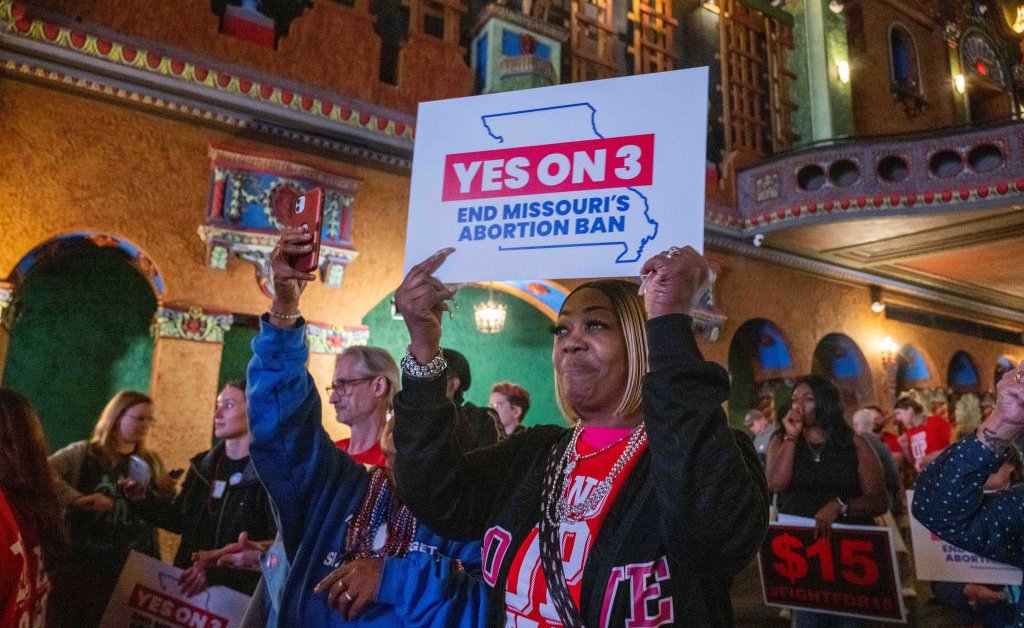In the 2024 Presidential election, voters simultaneously cast their ballot for abortion rights and for President-elect Donald Trump. A new Rutgers School of Public Health analysis shows that support for abortion ballot initiatives exceeded support for Vice President Harris in every state in which there was a measure.
Given Trump’s past full-throated claims of credit for the Supreme Court’s reversal of Roe v. Wade—and given how central abortion was to Vice President Harris’s campaign—the divergence has raised many an eyebrow. A New York Times article on the “split screen” outcome indicates abortion did not amount to voters’ top priority, as compared to immigration and the economy. The ACLU’s Political Advocacy Officer Deirdre Schifeling observed a “cognitive dissonance” among voters, and Montana State University professor and political theorist Sara Rushing suggested casting mixed ballots were a way for voters to “have [their] cake and eat it too.”
Rushing further notes the impact of Trump’s attempt to soften his stance on abortion during the campaign, his awareness of its political potency. To shut down debate and distance himself, he asserted the centrality of state-by-state policy, declaring on Truth Social: “The states will determine by vote or legislation, or perhaps both. At the end of the day, this is all about the will of the people.”
For voters who took Trump at his (more recent) word, the election outcomes are not just unsurprising, they also reinforce the bipartisan popularity of abortion rights. Since the Dobbs v. Jackson Women’s Health Organization ruling, ballot measures have passed in six states, even in unexpected places like Kansas. The 2024 election brought opportunities for an additional 10 states to have a direct voice. Meaning that for millions of voters, they were not just casting a ballot for abortion in their own state, but witnessing fellow citizens across a wide swath of the country do the same.
Read More: Why Abortion Rights Won in Three States That Voted for Trump
Against that backdrop, voters tuned in to the Trump campaign likely saw a system working exactly as they were told it would. Harris voters saw a continued catastrophe.
Now all abortion supporters must contend with the reality of how a Trump administration paired with a Republican-led Senate (and possibly House)—plus a conservative supermajority at the Supreme Court, a dynamic of Trump’s making—could easily undo their will. For split-ticket voters who helped return Trump to the White House, this means accepting that there is much unfinished business to tend to.
Even if Trump keeps his “word,” the federal government has multiple ways to ban abortion nationwide. Options range from the Department of Justice reviving enforcement of the long-dormant Comstock Act (an 1873 law, still on the books, that prohibits the mailing and receiving of materials used to produce abortions), to the Food and Drug Administration imposing further restrictions on prescribing abortion pills. Congress may pursue a national ban—or a “national minimum standard” to the same effect—which the president could sign or veto.
Split-ticket voters should be aware that even if their home state protects basic rights, they are not inoculated from the trickle-down effect of other states with bans. Abortion may still be hard to obtain, given higher demand or lack of meaningful access in many states even now, particularly for abortions beyond the first trimester of pregnancy. All pregnancies in the United States are more dangerous without abortion access.
The domino effect will show up in the broader healthcare system. OB-GYNs and midwives have left states with abortion bans; as medical students and residents go elsewhere to train, all reproductive care is harder to obtain. The people who provide care during the prenatal, labor and delivery, and postpartum period are the same people who provide abortions.
Health insurance policy matters too. Trump’s actions when last in office included multiple attempts to get rid of the Affordable Care Act (ACA), which has provided health insurance to close to 50 million people between 2014-2024. Among the required services are well-woman care and access to contraception without a co-pay. These national requirements mean that people who have private health insurance also have these benefits. If the protections in the ACA or the ACA itself is overturned, the result will be less access to preventive care, including to prevent pregnancy—taking us full circle back to abortion.
So what needs to happen—now and as the new administration begins?
We can all help ensure abortion access by understanding the current status in our own state. We can call out misinformation, which is likely to proliferate. We can give to local abortion funds that help people afford care, including collateral costs like travel. And we can exert pressure and remind political leaders of the numbers in this election: abortion is more popular than they are.






